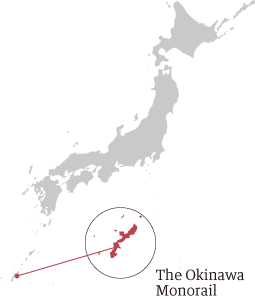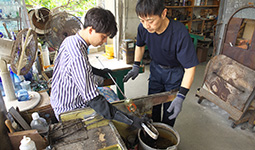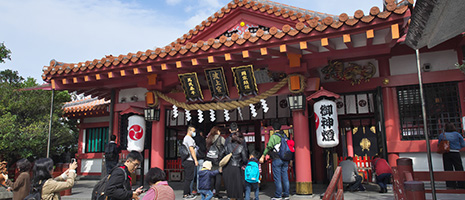- PREVIOUS
- NEXT
March 2020
Okinawa by Monorail

The Okinawa Monorail, popularly known as Yui Rail, provides tourists with access to a number of places and attractions blessed by beautiful blue skies and the natural beauty of the sea, as well as the long history of Okinawa’s unique culture influenced by the 450-year history of the Ryukyu Kingdom.

Popularly known as Yui Rail, the monorail system operated by Okinawa Urban Monorail, Inc. travels the 17 kilometers between Naha Airport in Naha City and Tedako-Uranishi in Urasoe City in about 40 minutes. It opened in August 2003, providing service between Naha Airport Station and Shuri Station, and was extended to Tedako-Uranishi from Shuri in October 2019.
Before the monorail came into service, automobiles were the primary means of transportation in Okinawa. Given the increasing concentration of the population and businesses in Naha City, the largest city of Okinawa, traffic congestion had become a very serious problem. Yui Rail was built to overcome this problem. The monorail’s name comes from the phrase yui maaru, which is Okinawan dialect meaning “mutual support.”
In 2004, Yui Rail transported approximately 11 million passengers, which has grown to around 19 million in 2019, becoming a primary means of transportation for local residents and visiting tourists with its on-time performance unaffected by traffic congestion.
The two-coach Yui Rail trains are unique, with their particularly Okinawan style. The design of the train features red lines along the sides of the cars with images of the iconic Shuri-jo Castle and seat covers done in the Ryukyu Kasuri pattern of traditional Okinawan clothing. People traveling on the trains can enjoy a great view from the trains’ elevated position 10 meters above the ground, and easy access to Okinawan sightseeing spots.
The Naha City Traditional Arts and Crafts Center is one popular tourist location. On Kokusai Street, it is amidst one of the largest shopping areas in Okinawa, just five minutes’ walk from Makishi Station. Okinawa has a variety of arts and handcrafts, influenced by the long history of trade with neighboring countries that has continued since the Ryukyu Dynasty (1429–1879) ruled Okinawa.
The Center boasts an impressive selection of works that are available for purchase, including Ryukyuan Bingata cloth dyed in vivid colors, beautiful Ryukyuan lacquerware, Shuri cloth, Shisa statues, Tsuboya-ware (pottery for daily use), and examples of Ryukyuan glassblowing. Visitors can also try their hand at these five traditional crafts in the Center’s workshop.

Naminoue-gu Shrine sits at the top of a bluff overlooking the Port of Naha, around 15 minutes from Asahibashi Station on foot. It is not known exactly when this shrine was built. Naminoue-gu Shrine has long been a spiritual place for local Okinawans. It became a shrine dedicated to nirai kanai, the mythical source of all life or utopia, seen as the sea gods, to ensure a bountiful harvest.

The Ryukyu Kingdom had a deep faith in Naminoue-gu Shrine. The King is believed to have visited the shrine every New Year’s Day, praying for the dynasty’s prosperity. Located under the bluff is Naminoue Umisora Park, which has a beach for swimming, snorkeling and barbecues.
Another popular spot is Shuri-jo Castle Park, a 15-minute walk from Shuri Station. Partially opened to the public in 1992, the park was restored with a focus on the castle’s role as the center of politics, diplomacy and culture during the Ryukyu Kingdom era. Buildings were restored and the park was extended in later years.
In 2000, “Gusuku Sites and Related Properties of the Kingdom of Ryukyu” were registered as a UNESCO World Heritage Site. (“Gusuku” means castle.) In the wake of the October 2019 fire, some areas of the park are off-limits. Meanwhile, around 80% of the area of the park prior to the fire has already been made accessible to the public, and people can visit places like Shureimon, one of the main gates to the complex (restored in 1958) and Iri-no-azana, a modern lookout tower overlooking downtown Naha and the sea.
Shuri-jo Castle Park is surrounded by traditional streets and structures reminiscent of the old dynasty, such as the Kinjo-cho stone paved path located on the southern slope of the castle park. Limestone was arranged in a mosaic pattern to pave the path in the early sixteenth century. The entire sloping path stretches approximately 300 meters with old private houses standing along both sides, creating a certain ambience unique to Okinawa.

Ride Yui Rail and enjoy the natural beauty of Okinawa’s blue skies and seas, and its unique culture developed by the long history of the Ryukyu Kingdom.
- PREVIOUS
- NEXT

